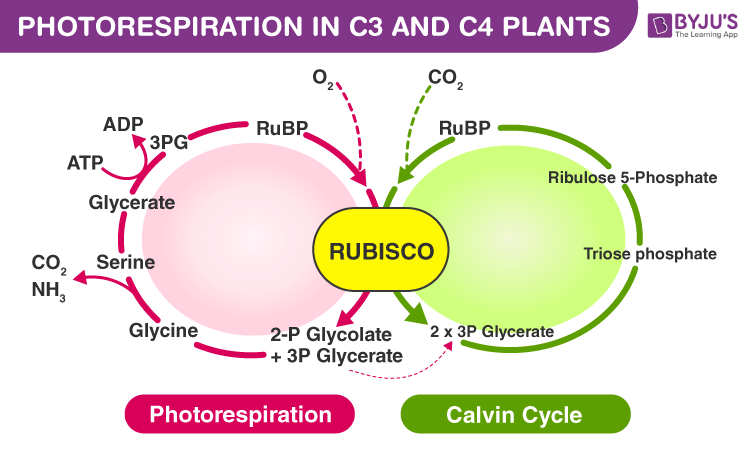As we all know, photosynthesis is a biochemical process of producing carbohydrates using light energy. The whole process is carried in two phases.
- Photochemical phase – In the photochemical phase, ATP and NADPH are produced
- Biosynthetic phase – In this phase, the final product glucose is formed.
Based on, how plants proceed in the biosynthetic phase, plants are further classified as C3 and C4 plants. Another factor which differentiates a C4 plant from C3 is photorespiration.
Photorespiration
Photorespiration is a respiratory process in many higher plants. This is also known as the oxidative photosynthetic, or C2 photosynthesis or carbon cycle.
For a better understanding of photorespiration, let’s recall the Calvin cycle, the first step of the biosynthetic phase in C3 plants- Plants which use only the Calvin cycle for fixing the carbon dioxide.
The reaction in which carbon dioxide and water combine to give carbohydrates is termed as carbon fixation. Calvin cycle is the first step of carbon fixation where CO2 combines with Ribulose-1 and 5-bisphosphate (RuBP) to form two molecules of 3 carbon acid called 3-phosphoglycericacid (PGA). The reaction is catalyzed by the most abundant enzyme in the world called RuBisCO (RuBP carboxylase-oxygenase). RuBisCO is the enzyme that has an affinity for both CO2 and O2 but has more affinity for CO2. Hence, the binding of CO2 and O2 are competitive in nature and the concentration of the molecules in the atmosphere determines the winner. This is the basis for photorespiration in plants.
Sometimes in C3 plants, RuBisCO binds to oxygen molecules and the reaction deviates from the regular metabolic pathway. The combination of RuBP and oxygen molecules leads to the formation of one molecule of phosphoglycerate and phosphoglycolate. This pathway is called photorespiration. During photorespiration, no sugar or ATP molecules are synthesized, but just CO2 is released at the expense of ATP and the whole process is futile.

However, C4 plants do not undergo photorespiration due to their special mechanism to increase the CO2 level for enzyme binding. During the Hatch and Slack Pathway, the C4 acid, oxaloacetic acid (OAA) breaks down to release CO2. This ensures the high concentration of intercellular CO2. Thus, in C4 plants, RuBisCO is more active as a carboxylase enzyme rather than as oxygenase. This is why C4 plants have better productivity.
For more detailed information about photorespiration, visit BYJU’S.

nice it can help